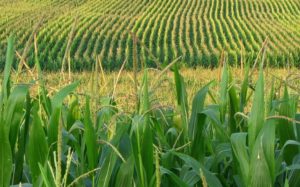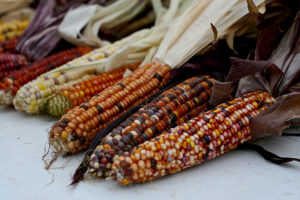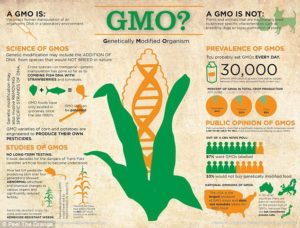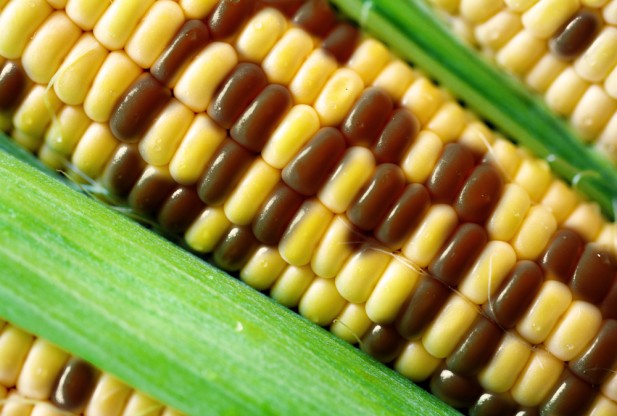I’ve been seeing a lot of articles lately about the use of GMO and non-GMO corn. I believe the conversation around GMOs is usually a bit off the mark. (one example- https://daily.sevenfifty.com/bourbon-producers-consider-the-pros-and-cons-of-non-gmo-corn/) Let’s clarify a few things.
The vast majority of corn and soybeans grown in the US are genetically modified organisms, aka GMOs. This means that the genetic material of an unrelated organism (in most cases, genes from single-celled organisms like bacteria or from more complex organisms like worms) have been inserted into the genome of a corn or soybean plant to improve that plant’s ability to survive and prosper. This modern form of bio-engineering is a great leap forward for science AND for agriculture! The fact that applied science can improve the success and sustainability of edible crops is truly incredible! We have all driven past beautiful fields of corn or soybeans – all of which are weed free, lush, green, huddled together, and almost identically uniform across acres and acres of land- and thought, “Wow, look at that beautiful countryside!” And we have science to thank for all that bounty. Corn and soy plants are more reliable, higher yielding, and more cost effective to grow than they have ever been. So, if GMOs are so great, why do so many people argue against them? Haven’t people been genetically modifying their crops for as long as we’ve been breeding plants? Well, no. GMOs are not the same thing as selective breeding. The term “genetically modified” is sly because they aren’t so much “modified” as they are “completely altered”. I guess “genetically altered” doesn’t have as nice a ring to it.
GMO’s are “modified organisms”- as in, modified in a laboratory. They are NOT the same as hybridized plants. Hybridization is the cross breeding of one varietal of plant to another of the same species. Often, one varietal of corn will perform better in certain climates or have shorter, sturdier stalks that are able to support the weight of a larger yielding ears or seed heads. A farmer may choose to create a cultivar by cross-breeding two different plants because they want to highlight a preferable genetic characteristic! Cultivars (or cultigens, cultivars aided by human activity) are produced by cross breeding two varietals. Farmers have been cross breeding plants for as long as farmers have been farming! That’s nothing new. Farmers select plants by pulling the ones they don’t like (up from the roots!) and only allowing the ones they DO like to grow and pollinate neighboring plants. GMO’s, on the other hand, are not created in the field. They are created in a lab through gene splicing. GMOs, in basic terms, have been forced to evolve. And NO amount of natural selection would ever create a GMO! Adding the genes of an animal to a plant is NOT possible in nature. While it’s an incredible feat of science, they could NEVER occur naturally.
Genetic modification AND hybridization are BOTH valid ways to create stronger plants that will perform better- literally speaking, in the field. The argument that GMO’s are bad for you is often a weak argument. There is nothing terrifying about corn that has been genetically modified. The seed is not the bad guy. It is just a kernel of corn. Let’s be VERY CLEAR HERE. A plant that grows from a genetically modified seed is not poisonous or bad for you! A GMO seed is perfectly safe! A plant grown from a GMO produces seeds that are perfectly safe! The real issues with GMOs, which are so often glossed over, are the CONSEQUENCES that come from overuse and over-reliance on these successful products by farmers across our country.
In the past, before laboratories and corporations held so much sway over agriculture, a farmer would grow crops that he/she cultivated from year to year. The natural selection that took place was due to a farmer selecting a higher yielding varietal of corn for his/her region and rainfall expectations and choosing the heartiest of those plants from which they’d save seeds to replant the following year. This is not to say that no one saves seeds anymore. You cannot save patented seeds, however. This is Bayer/Mansanto’s rationale for maintaining the right to sue farmers for reusing their highly successful seeds- https://monsanto.com/company/media/statements/saving-seeds/ This legal limitation creates a reliance on seed stock that did not exist before the advent of GMOs. That same source for seed is also providing the farmer with the weed-killer that the plants are bred to be resistant to. It’s a slippery slope, as you might imagine. The seed is not designed to do well in any specific town or region- GMOs are designed to do well under most conditions. A reliance upon GMOs is how a region loses its bio-diversity. Each farm, regardless of its location or microclimate, is growing the same seeds. Farmers are all growing a higher yielding crop, but they have no real ownership of their own crop. A better yield might produce a bigger paycheck , but the farmer can’t store seedstock from their own crop to plant the following year. This universal use of these genetically modified “magic beans” have created an entirely new problem. Yields are up, crops are performing well, but farmers are losing their ownership of their own produce.
GMO seeds are designed to perform well, almost universally. Regional concerns are not often properly addressed. If an agricultural region is known to receive less-than-adequate rainfall, the solution is to irrigate and draw more water from the available aquifer. If the location has soil which lacks nutrients because corn is being planted year after year, the simple solution has been to spread more nitrogen-rich fertilizer. If a farmer can’t seem to turn enough profit from their miraculous high-yielding GMO crop, the solution has been to just plant more acreage. And so, farmers are draining their aquifers, adding too much nitrogen to their local watersheds, and overextending themselves financially- all in the name of progress.

Today, corn and soy are so much more productive than other crops that farmers choose to rely on them almost entirely. This was not always the case. Regions of the country were specialized for certain crops. Rye grows better in cooler northern, rocky, less fertile areas. Soy tended toward northern, fertile soils. Wheat does better in warm climates (but not too warm) with 12-15 inches of rainfall the during growing season. Barley is a temperate climate plant. Corn, historically, thrived in warmer, southern regions and each locale had its own style of corn/maize. Different areas of the country grew different types of plants that thrived in each nuanced microclimate. This is not to say that these realities do not still exist, it is just far more likely that corporate farms will choose to grow their large crops in areas that are more easily manipulated. A drier, midwestern climate is ideal for many crops that can be maintained by sprinkler systems and customized fertilizations. If you fly over the Midwest of the US, you will see the many circles of green in an otherwise taupe environment. This is due to the sprinkler systems that pivot from a central point like a clock dial. Controlling your rainfall with groundwater and adding fertilizers where they are needed is ideal for controlling predictable crops, but it tends to neglect nature’s water table and add extra nutrients to local bodies of surface water, choking them with algae and killing fish and waterfowl populations.
Nature works in mysterious ways, but bio-engineered crops do not. Business loves predictability. Unfortunately, nature is not predictable. Nature and farming have battled each other since the dawn of civilization. Somehow, corporate farming believes they have the answers to civilization’s quest for dominance over agriculture. Every year, they are proven wrong with drought, flooding, climate change, invasive insects, stronger and more resilient plant diseases, and heartier weeds that have evolved to resist even the most weed-resistant GMO crop. It is the height of human vanity and arrogance to think that a few tweaks in the genetics of a plant will solve world hunger or make farming simple.
Being a farmer makes you part scientist, part local historian, part meteorologist, part chemist, part botanist, part small bu

siness owner and entrepreneur, part inventor, part plumber, woodworker, skilled tradesman, and mostly…exhausted. Each year, less people choose to take on the Herculean task of running a farm and who can blame them? Those that have survived grow that GM corn because it is more predictable and easy to sell in bulk. Who can blame a farmer for growing a crop that they know will help keep their farm productive and viable? GMOs and the loss of the integrity of the local farm has cost our country more than can be quantified. Our disconnection from our food, our disinterest in what makes our region special, and our disregard for farmers (often calling them fools for continuing to work their land) is a tragedy for our country.
Is a bowl of cereal made from GMO corn going to kill you? No. There is nothing evil about the seed that was grown with the aid of science. It is innocent in all this. Will the companies that continue to use our nation’s land and water irresponsibly going to profit from keeping us happy and ignorant? Will farms continue to disappear because they just can’t compete against a growing trend toward consistency, predictability and consolidation? Will a farmer choose to grow a crop that doesn’t produce as much final product to sell? Will they ever go back to growing organically (in any way) when it costs more and is more difficult to maintain organic crops? What do you say to your local farmer when they spray those toxic Round Up pesticides that have become as much a part of their farming practice as their GPS driven combine?
Technology doesn’t have to hurt farming. It just seems to me that the more we treat farming as a solvable problem, the more harm we do. The wisdom that generations of farmers have gained is being lost. The crime of GMOs is not in their seeds, it is in their hubris.


